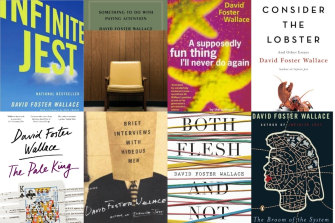By David Free
Author David Foster Wallace, who died in 2008.Credit:Alamy
It was a dark day for literature when David Foster Wallace took his life in 2008, at the age of 46. Wallace was hands-down the most talented American writer of his generation. Arguably he was one of the most striking and original prose stylists of the past century. And yet he’s never really been a household name, unless you live in an unusually highbrow household. He had enormous gifts, but an equally enormous propensity to get in his own way. Maybe that’s why America’s Wallace industry has been busier since his death than it was during his life. The man himself is no longer around to impose his artistic standards, which were both fanatically strict and strangely self-sabotaging.
In his lifetime Wallace published two novels, three story collections, and two volumes of non-fiction, along with sundry minor works. Since his death, his oeuvre has gone on growing. In 2009, his publishers had a hit with This is Water, a jazzed-up version of a commencement address Wallace delivered in 2005. The Pale King, the big unfinished novel he was working on at the time of his death, was published in 2011. A volume of previously uncollected essays appeared in 2012. So did D. T. Max’s biography, Every Love Story is a Ghost Story. In 2015 Jason Segel played Wallace in the movie The End of the Tour.
The latest addition to the Wallace canon is a hundred-page novella called Something to Do with Paying Attention. Actually, the text of the book isn’t new. Readers who made it past the middle of The Pale King – admittedly not a large cohort – will find they’ve read this novella before. It first appeared as The Pale King’s 22nd chapter, in the form of a memoir composed by one of that novel’s countless narrators.
Jesse Eisenberg and Jason Segel star in The End of the Tour.
Now it’s been re-issued as a stand-alone book, in a bid to solve a perennial Wallace problem: that of providing newcomers with a way into his work. “For someone who has never read Wallace,” the book’s publisher, Sarah McNally, writes in her preface, “this little book … is a perfect place to start.”
I’m not sure McNally is right about that. Removed from the bustling context of The Pale King, the story feels like an uncharacteristically minor-key performance. Newbies who start here are liable to wonder what all the fuss is about.
Still, McNally is right to feel that Wallace’s reputation is due for a booster shot. This is doubly true in Australia, where Wallace is criminally under-appreciated. His books have never sold well here, and this new one doesn’t even have an Aussie distributor.
If this novella isn’t the perfect introduction to Wallace, then what is? The awkward fact, which McNally hints at but doesn’t dare to mention aloud, is that Wallace never produced a wholly satisfactory book. Unfortunately, he wasn’t his own best critic or curator. He had a maddening tendency to barricade his gorgeous prose behind needless entanglements of textual barbed wire.
This has always presented his fans with a challenge. If you love his stuff – as I do – then how do you spread the word about it? Even his best books can’t be recommended without a caveat or two: read this bit, but don’t hesitate to skip or skim that one.
What makes the Wallace problem so vexing is that his best stuff really was incredibly good. When he was on song, Wallace produced sentences that made his most gifted contemporaries feel like quitting on the spot.
Where does a new reader start when it comes to David Foster Wallace?
Here he is covering a tennis match between Pete Sampras and Mark Philippoussis. “Sampras, poor-postured and chestless, smiling shyly at the ground, his powder-blue shorts swimming down around his knees, looks a little like a kid wearing his father’s clothes.”
How’s that for a word-picture? And how’s this for a cruel but fair evocation of The Poo? “The malevolent but cyborgian Philippoussis hasn’t betrayed anything like an actual facial expression yet.” Between points he likes to “dance a little in place – perhaps to remind himself that he can indeed move if he needs to.”
Wallace’s journalism showcased his superb ability to register the world in front of his eyes. In the best passages of his fiction, he did something even trickier. In the same deft style, he registered the world inside his head. He could catch a thought in flight. Here’s one of the narrators of The Pale King, sitting on an infernally hot bus:
The sun began shortly to broil the bus’s rear and port side. The air-conditioning was more like a vague gesture toward the abstract idea of air-conditioning. There was a horrific piece of graffiti incised with knife or leather punch in the plastic of the seatback in front of me, which I looked at twice and then made a point of never looking directly at again. The bus had a lavatory in the wayback rear, which no one ever made any attempt to use, and I remember consciously deciding to trust that the passengers had good reason for not using it instead of venturing in and discovering that reason for myself.
Author David Foster Wallace at the New Yorker Magazine Festival in 2002.Credit:Getty Images
Notice how the sentence about the feeble air-conditioning can hardly be bothered being a proper sentence. Wallace’s very syntax feels heat-affected. And notice how the narrator doesn’t just not look at the graffito again. He makes a point of not looking at it again. This is how thought moves, and Wallace had a supreme ability to follow its twists and turns in language.
The word genius isn’t out of place for Wallace. He could go on like this for page after page, spraying out jaw-dropping sentences seemingly at will. His intelligence was vast, and his writing let you all the way into it. His verbal talent was on a par with James Joyce’s. But he was a Joyce for our time. His best prose was slangy, hyper-modern, tech-savvy, and laugh-out-loud funny.
Alas, Wallace had something else in common with Joyce. Maybe because he could produce breathtaking prose without really trying, he also felt a restless urge to overegg the pudding, by conducting formal experiments that seemed positively designed to shut readers out. “Just how much reader-annoyance are you shooting for here exactly?” said his sister Amy, when vetting one of Wallace’s manuscripts. This is the lingering question about Wallace. What was the deal with the reader-annoyance?
One answer is that he lacked discipline. The guy just didn’t know how to stop himself. His best-known novel, Infinite Jest, was 1100 pages long, and included a hundred pages of minutely printed endnotes. As Max reveals in his biography, the novel’s draft was 600 pages longer. Wallace’s editor had to fight him tooth and nail to reduce the book to the width of a mere housebrick.
Wallace’s running battles with editors are a motif of Max’s biography. When commissioned to write magazine articles, Wallace routinely handed in unfeasibly massive, manically brilliant drafts that were as long as small books, and riddled with post-modern interpolations (subheadings, upside-down text, footnotes, footnotes to footnotes).
“The biggest challenge to editing Dave’s non-fiction,” said one of his editors, “was in striking a balance between the magazine’s needs and his instinctual impulse to not give a f— about the magazine’s needs.”
The “new” David Foster Wallace
- The latest addition to the Wallace canon is a hundred-page novella called Something to Do with Paying Attention.
- The novel first appeared as The Pale King’s 22nd chapter, in the form of a memoir composed by one of that novel’s countless narrators.
- The coming-of-age story follows a young man, a “wastoid” living in the suburban midwest in the US in the 1970s, and his encounter with tax law.
- Publisher Sarah McNally writes in her preface that the novel is: “not just a complete story, but the best complete example we have of Wallace’s late style, where calm and poise replace the pyrotechnics of Infinite Jest and other early works.”
Writing fiction, Wallace was even freer to not care about user-friendliness. But perhaps that’s the wrong way to put it. There was nothing careless about Wallace’s commitment to being difficult. His stuff was inaccessible on purpose. Wallace made his living as a creative-writing professor, and his fiction always had a regrettable whiff of the seminar room. Heeding the commandments of cutting-edge literary theory, he denied his readers the old-fashioned pleasures of plot and narrative closure. In his notes for The Pale King, Wallace urged himself, all too successfully, to make the book feel like “a series of setups for things to happen but nothing ever happens … something big threatens to happen but doesn’t actually happen.”
Sometimes you wonder how great a novelist Wallace might have been, if his narratives had been as shapely and welcoming as his best sentences. But it’s an idle thought. The forbidding texture of Wallace’s fiction wasn’t just a matter of academic theory. It also had to do with his profound unease about success and fame. He both wanted and didn’t want these things. His fiction reflected that ambivalence. It gave with one hand, sometimes to a ridiculously generous degree, but took away with the other.
Wallace was a complicated man, whose life was darkened by the shadows of depression and addiction. His friend and fellow novelist Jonathan Franzen called him “a lifelong prisoner on the island of himself.” Writing fiction, Franzen said, “was his way off the island”, his way of connecting with others.
When he was on song, Wallace produced sentences that made his most gifted contemporaries feel like quitting on the spot.
But after years of wrestling with The Pale King, Wallace became desperately blocked – “bored with his old tricks,” as Franzen put it, “and unable to muster enough excitement about his new novel to find a way forward with it.” Far from getting him off the island, his convoluted final book left him comprehensively marooned.
While Wallace was alive, one barracked for him to produce the masterpiece that would do full justice to his talents. Now that he’s gone, we must make do with his existing works, and reconcile ourselves to the fact that his excesses were part of his essence. Without the reader-annoyance, Wallace wouldn’t be Wallace.
As for the best place to start, I think the answer lies in his non-fiction. Try his scintillating essay about a bad luxury cruise, A Supposedly Fun Thing I’ll Never Do Again, which appears in the collection of the same name. If that doesn’t make you fall in love with Wallace, nothing will.
And if it does, you’ll be ready for the more exacting pleasures of his fiction. I was about to say, and then you’ll be on your own. But that’s exactly how you don’t feel, when you’re in the company of a writer as marvellous and infuriating as David Foster Wallace.
A cultural guide to going out and loving your city. Sign up to our Culture Fix newsletter here.
To read more from Spectrum, visit our page here.
Most Viewed in Culture
Source: Read Full Article






